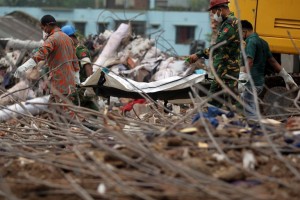8 dead in new Bangladeshi textile fire

Bangladeshi rescue personnel carry stretchers with the remains of garment workers from the site of a collapsed building in Savar on the outskirts of Dhaka, on Thursday, May 9, 2013. The death toll from Bangladesh’s worst industrial disaster exceeded 900 on Thursday as rescuers pulled out dozens more bodies from the rubble of a nine-story building that collapsed outside Dhaka last month. AFP/PHOTO/STR
DHAKA—A fire at a garment factory killed eight people Thursday in the latest disaster to hit Bangladesh’s textile industry, still reeling from the death of more than 950 people in a building collapse.
The cause of the fire was not known, but authorities said it broke out during the night on the third floor of an 11-story building housing garment factories of the Tung Hai group in Dhaka’s Darussalam district.
The Tung Hai’s owner was among the victims, but there were no workers among the casualties since there was no overnight production, police and fire service officials said.
“It was a big fire but we managed to confine it on one floor,” Mahbubur Rahman, operations director of the nation’s fire service, told AFP.
He said the victims suffocated after rushing into a stairwell and becoming overwhelmed by toxic smoke from burnt acrylic clothing.
Article continues after this advertisementLocal police chief Khalilur Rahman told AFP the fire killed the owner, his four staff, a senior police officer, a low-level police official and an eighth person not yet identified.
Article continues after this advertisementRahman said there were no workers in the factory when the blaze broke out some time after 11.30 pm. “Only the owner, his staff and his friends were there on an upper floor,” he said.
One of the victims was a mid-ranking member of the ruling Awami League party, police said.
National fire chief Ahmed Ali told AFP the factory had the “roof-gate locked” but it had a fire license until June this year with fire safety measures found to be “satisfactory.”
“The fire originated at the ironing section of the factory where there was a stockpile of acrylic sweaters. The burning of these sweaters created toxic carbon monoxide smoke, which then spread to the upper floors,” Ali said.
“The eight people who died rushed to a gate leading onto the roof, but it was locked. They then tried to come downstairs but they were overwhelmed by toxic smoke in the stairwell.”
Tung Hai is one of the country’s largest garment groups with annual exports of around $200 million, according to the Bangladesh Garment Manufacturers and Exporters Association.
Tung Hai said on its Facebook page that British chain Primark was among its customers.
Spain’s Inditex, whose labels include Zara, confirmed it had placed orders in the past but severed ties last June after Tung Hai’s management “did not respond accordingly” to a plan to improve working conditions.
The fire comes as more bodies were found in the ruins of the nine-storey Rana Plaza garment factory complex that caved in on April 24 when more than 3,000 workers were on shift.
Over 100 more bodies were recovered overnight, bringing the confirmed death toll to 953, according to the army.
Brigadier General Siddiqul Alam Sikder, overseeing the recovery operation, told AFP he hoped to wrap up work on Friday and then leave bulldozers to shift the remaining rubble.
Bangladesh is the world’s second-largest apparel maker and the $20 billion industry accounted for up to 80 percent of annual exports last year.
But it has a shocking safety record and Western retailers have been threatening to pull out unless authorities come up with a credible programme to raise standards. Disney has already done so.
The government Wednesday announced the closure of 18 garment plants, days after it promised to give “the highest consideration” to safety after talks with the International Labor Organization.
Fire is a common problem in the 4,500 garment factories in Bangladesh, with many operations based in badly constructed buildings with sub-standard wiring.
In November 111 people died after a fire engulfed the Tazreen Fashion factory outside Dhaka, the worst blaze in the history of the country’s garment industry.
Around 700 people have been killed in garment factory fires in the country since 2006, according to the Amsterdam-based Clean Clothes Campaign group.
Western retailers have criticised the factories for not ensuring worker safety, but major brands continue to place orders and critics say they turn a blind eye to the endemic problems.—Shafiq Alam